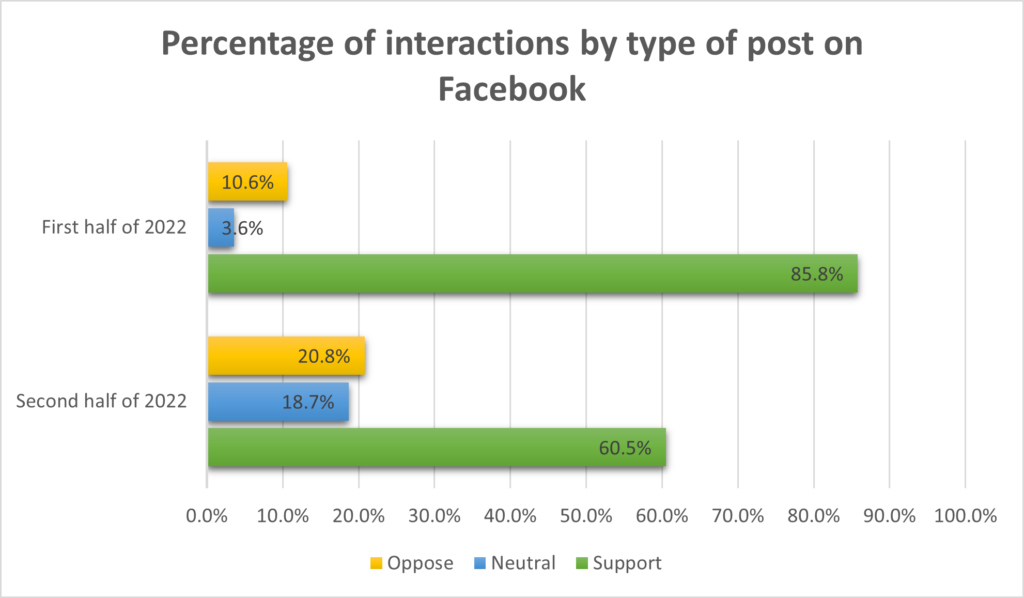45north, in partnership with the International Republican Institute’s Beacon Project, analyzed Romanian language social media data from Facebook, Twitter and Telegram for the second half of 2022, data associated with the war in Ukraine. You can find the full report above, including the methodology applied to the analysis.
In our previous report, which you can read here, we analyzed the top 100 posts on social media related to Ukrainian refugees from the first half of 2022 and now we will compare those numbers with the insights from the second half of the year. We want to understand what were the main disinformation narratives present and if hate speech permeated the social media conversation.
Key takeaways
- Facebook remains the preferred social media platform for Romanians with the number of median interactions per post for Facebook (33514) far surpassing Twitter (17) and Telegram (1511). This means that the specific mechanics involved in using Facebook (for example, participating in Facebook groups) are relevant to how disinformation and malign narratives spread within the Romanian language social media ecosystem.
- The topic of the Ukrainian refugee crisis has appeared significantly less in the Romanian social media conversation in the second half of 2022, compared to the first half, with almost 83% less interactions for the top 100 posts.

- Posts from Moldova continued to weigh heavily in the distribution of total interactions for the analyzed posts, with 41,1% of the total Facebook interactions, adding to our commentary in the first report, that Moldova outweighs its demographic ratio with Romania when it comes to social media relevance, at least on this particular topic.

- While the total number of interactions coming from posts that support Ukraine is still in a clear majority (60,4% for Facebook and 58,5% for Twitter), we see a significant drop in these percentages when compared to the previous report. (for the first part of the year 85,8% of interactions supporting Ukrainian refugees on Facebook and 87,8% of interactions on Twitter).

- The second half of the year confirmed once again that Twitter is not the social media platform of choice for Romanians, nor for Moldovans, as the total number of interactions dropped from 9854 to 1704, for the top 100 relevant posts.
- Twitter posts opposing Ukrainian refugees mostly come from unknown and/or questionable sources, that just tweet statements, without any evidence or links. For example, one user has four posts (from a total of 18 posts opposing Ukrainian refugees) in this analysis, where she anecdotally says that Ukrainian refugees are painting swastikas in the UK or how she heard two children in a bus talking how Ukrainian children coming to Romania get more money on a monthly basis than their state allowance. This type of speech can be more easily defined as hate speech as it paints all Ukrainian refugees as Nazi sympathizers, and it also implies that all of them wrongfully and premeditatedly benefit from Romania’s resources.
- For Telegram, the syntax used for the query generated only fourteen posts, with 21162 interactions that referred to Ukrainian refugees. All of the analyzed posts were from Romania and thirteen were in opposition of Ukrainian refugees and one neutral, coming from four Questionable or Fake/ Conspiracy sources. The posts generally relativized the suffering of Ukrainian refugees, questioning their status and pushing the idea that Romanians and the Romanian government should first take care of its own citizens, implying that this responsibility and the responsibility of helping refugees are in a zero sum game.
- Hate speech that follows the exact definition stated by the United Nations is mostly absent from the analyzed data (the use of pejorative terminology, for example) but political speech against funding the refugees or skewed content from mainstream media tends to gather social media users in the comments that clearly express hate speech. In other words, for either political gains or clicks and viewership, politicians and/or media organizations appeal to the worst impulses and nurture a culture of hate towards the refugees and towards Ukraine’s cause.
Authors: Dragoș Ghimpe, Dragoș Tîrnoveanu
This report has been prepared with support from IRI's Beacon Project. The opinions expressed are solely those of the author and do not reflect those of IRI.
The link to the full publication can be found: here.